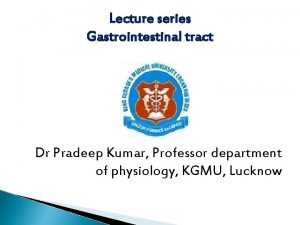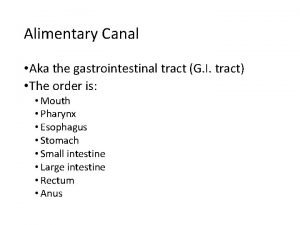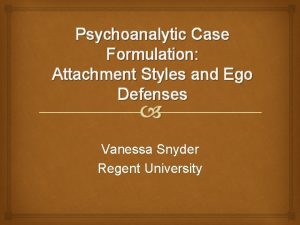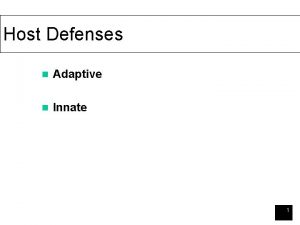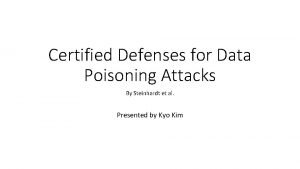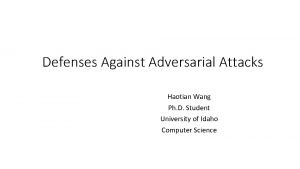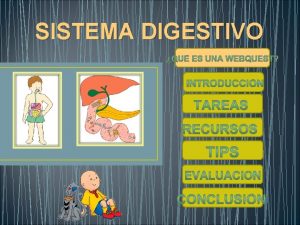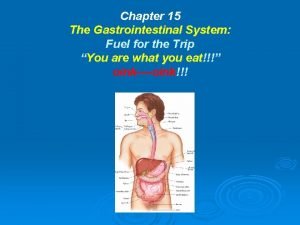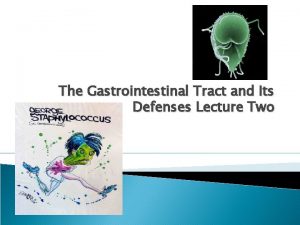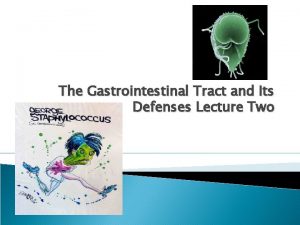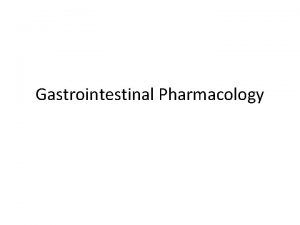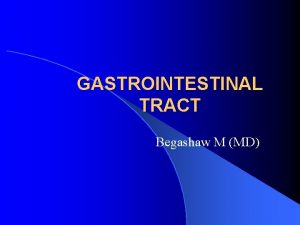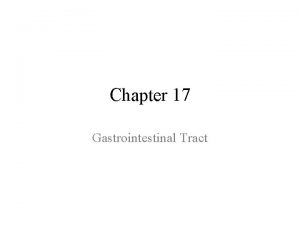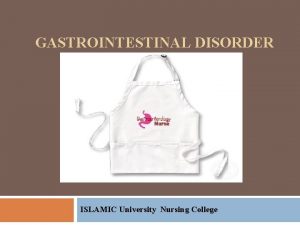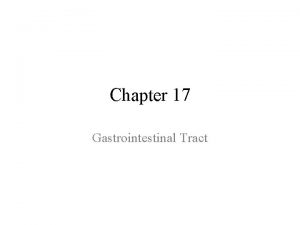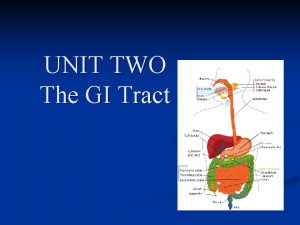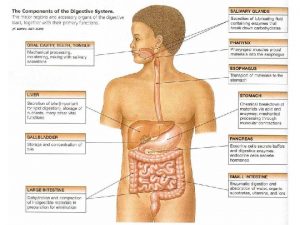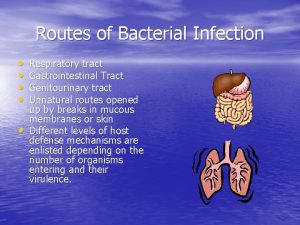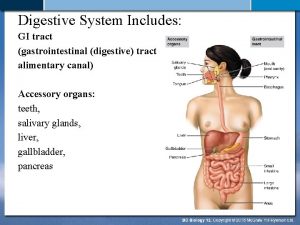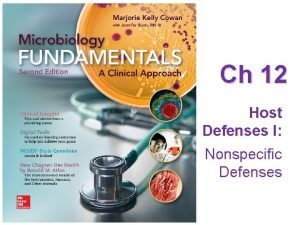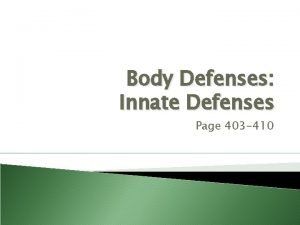The Gastrointestinal Tract and Its Defenses Lecture One

















- Slides: 17

The Gastrointestinal Tract and Its Defenses Lecture One

The Gastrointestinal Tract and Its Defenses • • • GI tract is composed of eight main sections and augmented by four accessory organs Eight sections: mouth, pharynx, esophagus, stomach, small intestine, large intestine, rectum, and anus Accessory organs: salivary glands, liver, gallbladder, and pancreas Also known as the digestive tract or alimentary canal The GI tract is an internal tube (lumen) that passes through the body; only chemicals absorbed through the GI tract actually gain entrance to the internal portions of the body

Defenses Gastrointestinal Tract • • • Mucus Secretory Ig. A Peristalsis Fluids with antimicrobial properties: saliva, stomach fluid, bile GALT tissues: tonsils, adenoids, lymphoid tissue in the esophagus, Peyer’s patches, appendix Microbial antagonism

Normal Biota of the Gastrointestinal Tract Large variety of normal biota Oral cavity alone: more than 550 known species of microorganisms Esophagus and stomach much more sparsely populated Large intestine: billions of microorganisms


Gastrointestinal Tract Diseases Caused by Microorganisms Tooth and Gum Infections ◦ If left undisturbed, normal biota biofilm eventually contains anaerobic bacteria that can damage the soft tissues and bones (periodontium) surrounding the teeth ◦ Introduction of carbohydrates to the oral cavity can result in breakdown of dentition

Dental Caries (Tooth Decay) Most common infectious disease of human beings Symptoms: often noticeable, but range from minor disruption in the enamel to complete destruction of the enamel and deeper layers Deeper lesions can result in infection to soft tissue inside the tooth leading to a toothache


Periodontal Disease 97% to 100% of the population has some manifestation of it by age 45 Most are due to bacterial colonization and varying degrees of inflammation

Periodontitis Initial stage: gingivitis (swelling, loss of normal contour, patches of redness, and increased bleeding of the gingival) If persists, periodontitis develops ◦ Extension of gingivitis into the periodontal membrane and cementum ◦ Increases the size of pockets between the tooth and the gingival and can cause bone resorption enough to loosen and possible lose the tooth

Necrotizing Ulcerative Gingivitis and Periodontitis Syntergistic infections infolving Treponema vincentii, Prevotella intermedia, and Fusobacterium species Together they produce several invasive factors that cause rapid advancement into the periodontal tissues Severe pain, bleeding, pseudomembrane formation, and necrosis

Mumps • • Incubation period 2 o to 3 weeks Initial symptoms: fever, nasal discharge, muscle pain, and malaise May be followed by inflammation of the salivary glands, producing gopherlike swelling of the cheekcs (parotitis) Multiplication in the salivary glands followed by invasion of other organs, especially testes, ovaries, thyroid gland, pancreas, meninges, heart, and kidneys

Gastritis and Gastric Ulcers • • • Heliobacter pylori thrives in the acidic environment of the stomach and has been linked to a variety of gastrointestinal ailments Gastritis: sharp or burning pain emanating from the abdomen Gastric ulcers are actual lesions in the mucosa of the stomach Duodenal ulcer: lesion in the uppermost portion of the small intestine Severe ulcers can be accompanied by bloody stools, vomiting, or both Long-term infection with H. pylori might be a contributing factor to stomach cancer

Acute Diarrhea In the U. S. , up to a third of all cases transmitted by contaminated food Most cases are selflimiting and do not require treatment Some (E. coli O 157: H 7) can be devastating

Acute Diarrhea Caused by Salmonella • • Salmonellosis: can be severe (elevated body temperature and septicemia) or mild (vomiting, diarrhea, and mucosal irritation); symptoms usually spontaneously subide after 2 to 5 days Typhoid fever: fever, diarrhea, and abdominal pain; the bacterium infiltrates the mesenteric lymph nodes and the phagocytes of the liver and spleen; progressive and invasive that leads eventually to septicemia

Figure 22. 10

Acute Diarrhea Caused by Shigella Causes the most severe form of dysentery Uncommon in the U. S. Frequent, watery stools, fever, and intense abdominal pain Nausea and vomiting are common Often bloody stools
 Gastrointestinal tract
Gastrointestinal tract Gastrointestinal tract
Gastrointestinal tract Composition of stomach
Composition of stomach Gastrointestinal tract
Gastrointestinal tract Difference between pyramidal and extrapyramidal tract
Difference between pyramidal and extrapyramidal tract Rubrospinal tract
Rubrospinal tract Chapter 12 the lymphatic system and body defenses
Chapter 12 the lymphatic system and body defenses Quizlet
Quizlet Chapter 12 the lymphatic system and body defenses
Chapter 12 the lymphatic system and body defenses Emt chapter 18 gastrointestinal and urologic emergencies
Emt chapter 18 gastrointestinal and urologic emergencies Primitive coping mechanism
Primitive coping mechanism Host defenses
Host defenses On adaptive attacks to adversarial example defenses
On adaptive attacks to adversarial example defenses Certified defenses for data poisoning attacks
Certified defenses for data poisoning attacks Nicolas papernot
Nicolas papernot 01:640:244 lecture notes - lecture 15: plat, idah, farad
01:640:244 lecture notes - lecture 15: plat, idah, farad Embriologia del sistema gastrointestinal
Embriologia del sistema gastrointestinal Chapter 15 the gastrointestinal system
Chapter 15 the gastrointestinal system

